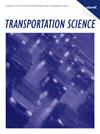汽车运输车装载问题的装载因子优化
IF 4.8
2区 工程技术
Q1 OPERATIONS RESEARCH & MANAGEMENT SCIENCE
引用次数: 0
摘要
对于汽车原始设备制造商(oem)来说,乘用车分销是一项复杂的任务,也是一项高成本因素。在从生产工厂到客户的途中,车辆通过不同的载体进行长途运输,例如船舶、火车和卡车。为了节省成本,oem和物流服务提供商的目标是最大限度地提高他们的装载能力。现代汽车运输车非常灵活。单个平台可以旋转、扩展或组合,以容纳不同形状和重量的车辆,并以最佳利用可用空间的方式嵌套它们。在实践中,找到可行的组合是借助于简单的启发式或基于个人经验。在研究中,大多数关于汽车载货问题的论文都集中在路线优化或成本优化上。只考虑加载子问题的粗略近似。在本文中,我们提出了两种不同的方法来近似实际负载因素考虑到现代汽车载体的灵活性和他们的高度,长度和重量的限制。基于我们的行业合作伙伴的流程,车辆分销遵循先进先出的原则。对于第一种方法,我们将问题表述为一个混合整数,二次约束分配问题。第二种方法将该问题视为具有不规则形状的二维嵌套问题。我们使用来自一家大型德国汽车制造商的真实世界数据进行计算实验,以验证和比较两种模型,并与根据文献改编的近似模型进行比较。第一种方法的仿真结果显示,与目前的行业解决方案相比,平均而言,9.37%的汽车运输公司可以装载额外的车辆。这意味着总成本减少了1.36%。嵌套方法的性能稍微差一些,但事实证明,它非常适合检查负载组合的可行性。本文章由计算机程序翻译,如有差异,请以英文原文为准。
Load Factor Optimization for the Auto Carrier Loading Problem
The distribution of passenger vehicles is a complex task and a high cost factor for automotive original equipment manufacturers (OEMs). On the way from the production plant to the customer, vehicles travel long distances on different carriers, such as ships, trains, and trucks. To save costs, OEMs and logistics service providers aim to maximize their loading capacities. Modern auto carriers are extremely flexible. Individual platforms can be rotated, extended, or combined to accommodate vehicles of different shapes and weights and to nest them in a way that makes the best use of the available space. In practice, finding feasible combinations is done with the help of simple heuristics or based on personal experience. In research, most papers that deal with auto carrier loading focus on route or cost optimization. Only a rough approximation of the loading subproblem is considered. In this paper, we present two different methodologies to approximate realistic load factors considering the flexibility of modern auto carriers and their height, length, and weight constraints. Based on our industry partner’s process, the vehicle distribution follows a first in, first out principle. For the first approach, we formulate the problem as a mixed integer, quadratically constrained assignment problem. The second approach considers the problem as a two-dimensional nesting problem with irregular shapes. We perform computational experiments using real-world data from a large German automaker to validate and compare both models with each other and with an approximate model adapted from the literature. The simulation results for the first approach show that, on average, for 9.37% of all auto carriers, it is possible to load an additional vehicle compared with the current industry solution. This translates to 1.36% less total costs. The performance of the nesting approach is slightly worse, but as it turns out, it is well-suited to check load combinations for feasibility.
求助全文
通过发布文献求助,成功后即可免费获取论文全文。
去求助
来源期刊

Transportation Science
工程技术-运筹学与管理科学
CiteScore
8.30
自引率
10.90%
发文量
111
审稿时长
12 months
期刊介绍:
Transportation Science, published quarterly by INFORMS, is the flagship journal of the Transportation Science and Logistics Society of INFORMS. As the foremost scientific journal in the cross-disciplinary operational research field of transportation analysis, Transportation Science publishes high-quality original contributions and surveys on phenomena associated with all modes of transportation, present and prospective, including mainly all levels of planning, design, economic, operational, and social aspects. Transportation Science focuses primarily on fundamental theories, coupled with observational and experimental studies of transportation and logistics phenomena and processes, mathematical models, advanced methodologies and novel applications in transportation and logistics systems analysis, planning and design. The journal covers a broad range of topics that include vehicular and human traffic flow theories, models and their application to traffic operations and management, strategic, tactical, and operational planning of transportation and logistics systems; performance analysis methods and system design and optimization; theories and analysis methods for network and spatial activity interaction, equilibrium and dynamics; economics of transportation system supply and evaluation; methodologies for analysis of transportation user behavior and the demand for transportation and logistics services.
Transportation Science is international in scope, with editors from nations around the globe. The editorial board reflects the diverse interdisciplinary interests of the transportation science and logistics community, with members that hold primary affiliations in engineering (civil, industrial, and aeronautical), physics, economics, applied mathematics, and business.
 求助内容:
求助内容: 应助结果提醒方式:
应助结果提醒方式:


